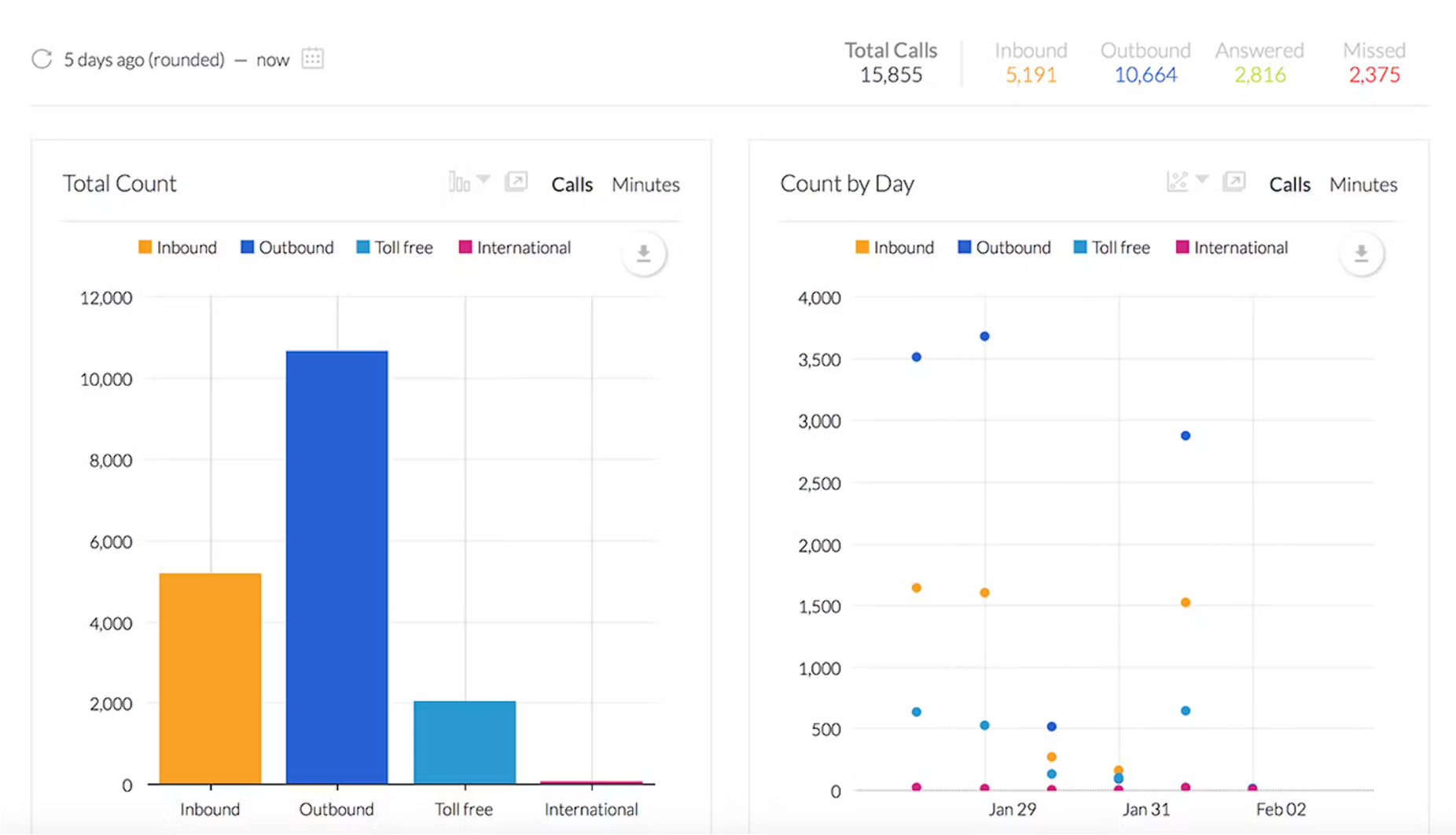Businesses need to be able to communicate with customers and employees efficiently, seamlessly, and reliably.
Modern consumers expect highly responsive, personalized communication from the companies they do business with.
It should be no surprise then, that Unified Communications as a Service (UCaaS) - a cloud-based business communications solution that connects people, processes and systems on a single unified platform - is valued at 56.14 billion in 2025.[*]
UC platforms enable omnichannel, real-time communication and team collaboration alongside agent monitoring, business process automation, and analytics. Read on to learn about the main benefits of UC.
Essential Benefits of Unified Communications
Unified communications improves customer service and employee productivity while cutting communication costs without sacrificing reliability and platform security.
Here are the top benefits of switching to Unified Communications.
- Improved Team Productivity
- Streamline Onboarding
- Increase Job Satisfaction
- Reduce Operational Costs
- Implement Remote/Hybrid Work
- Reduce Maintenance Costs
- Improve Scalability
- Business Analytics
- Seamless Omnichannel Communication
- Increase Security and Compliance
- Improve Customer Experience
1. Improved Team Productivity
Increased team productivity is one of the most notable benefits of Unified Communication. With a UC platform, employees can communicate in real-time on the channel of their choice, improving project collaboration, increasing first contact resolution rates, and eliminating workflow bottlenecks. One study found that companies switching to. unified communications saw an average 52% increase in productivity.[*]

Here are some ways that unified communications improves team productivity
- Integrated notifications and alerts: Users can customize notifications and alerts, update their user presence status to keep team members informed, set up messaging alerts and meeting reminders, and quickly access key customer data
- Unified interface: Users leverage omnichannel syncing and third-party integrations to avoid toggling between different apps
- Real-time communication: Team members stay on the same page by communicating and collaborating via chat, voice and video calls
- Faster resolution times: Having instant access to customer records and relevant information means that agents are wrapping up calls faster and more effectively
- Less down time: Smart call routing flows such as longest idle time ensure that agents spend as much time as possible interacting with customers
2. Streamline Onboarding
A Unified Communications platform improves the onboarding and employee training process by allowing companies to quickly create a robust training program for new hires. With access to an effective training program powered by UC, call center efficiency and productivity can improve by up to 56%, along with increases in customer satisfaction and agent retention.[*]
Here are some ways that UC streamlines the onboarding process:
- Video recording and transcription: Team members can watch pre-recorded lessons and learn at their own pace with instant access to everything they need
- Call monitoring: Team members get real-time feedback from managers through features like Call Whisper, Barge, and Takeover
- Screen pops: Displays important contextual information such as purchase history, geographic location, order status, etc., as well as relevant knowledge base articles during calls
- Team chat: Connects remote employees from across the globe, allowing them to work together seamlessly
- Call recording playlists: Supervisors can curate playlists showcasing the dos and don'ts of handling customer calls
3. Increase Job Satisfaction

UC platforms eliminate time-consuming repetitive tasks which increase the chance of human error, drain motivation, and ultimately lead to increased employee burnout. When employees no longer have to worry about repetitive tasks, they save time and can focus on the more challenging, meaningful work they were hired for. Additionally, companies can save 30% or more in operational costs when they begin to automate tasks.[*]
Here are the ways that unified communications can increase job satisfaction:
- Custom Workflow Automations: Almost any repetitive task can be automated, including outbound dialing, call forwarding, business text messaging, and running analytics reports
- Remote Work Capabilities: With the flexibility to work from anywhere, employees are able to achieve better work-life balance, lower commute times, and save money on things like eating out
- Self-Service Options: Self service features such as chatbots can take over the frequently asked questions, allowing agents to focus on more challenging issues
- Gamification: Leaderboards and reward systems allow agents to receive external motivation and feel more appreciated by superiors
- Regular Evaluations and Promotions: UC keeps supervisors organized so that they can give agents regular feedback, evaluations, and promotions based on accurate performance data
4. Reduce Operational Costs
Unified Communication and Collaboration solutions help companies reduce costs. Small businesses can save up to 40% on communication costs alone by switching to a UC platform.[*]
Here are some ways that unified communications reduces costs:
- Managed Service: Power outages, downtime and other technical issues are handled by the provider, eliminating the need for an in-house IT staff
- Fewer Interruptions in Service: UCaaS providers offer SLA guaranteed uptimes of at least 99.9%, meaning your team will experience far fewer costly interruptions in service
- Unified Interface: Users avoid buying different software for collaboration tools, telephony, customer relationship management (CRM), etc., further reducing IT costs
- Mobile and BYOD policies: Companies save on equipment costs by having employees use mobile devices
5. Implement Remote/Hybrid Work
Since teams can stay connected anywhere, at any time, and on any device, UC software helps businesses transition from in-person to remote or hybrid teams. Over 40% of all professional jobs in North America being remote or hybrid in 2023, the benefits to working from home are no longer a secret.[*]
Benefits of remote/hybrid work include:
- Better work-life balance for employees: Employees that work from home have a shorter work day since they don't have a commute
- Increased productivity: Agents working from home can set up an ideal workspace that is suited to their particular needs helping them focus
- Reduced costs: Companies save on utilities, office equipment, coffee, etc. wth remote workers
- Employees take less time off: Team members that work remotely are more likely to get adequate rest and less likely to be exposed to viruses that might be going the office
- Reduced employee turnover: Employees generally prefer to work from home and are less likely to leave a job that offers them this flexibility
6. Reduce Maintenance Costs
Because UC platforms are cloud-based and hosted by the provider, end users no longer need to pay for maintenance costs.
Here is how UC reduces maintenance costs:
- Eliminate the need for multiples of the same product: Such as phones, fax machines, and other expensive equipment—reducing both capital expenditures and operational expenses
- Automatic updates: Eliminates the need for expensive equipment upgrades, long-distance calling, and energy usage
- Team members can use their own devices: The UC system can be accessed from smartphones and personal desktop computers–so there’s really no need to buy new hardware
7. Improve Scalability

Scaling a business is costly, especially for small businesses and SMBs. The upfront costs of hiring new workers, purchasing new equipment, or renting a larger office space makes growing challenging or outright impossible for teams on a tight budget. With UCaaS, companies are likely to experience more cost savings, the more they scale.[*]
Here are some ways UC can be used to cut scaling costs:
Due to the mobile nature of UC, growing companies can implement
- Self-service onboarding: New hires can go through training at their own pace using pre-recorded videos, quizzes, etc.
- Bring your own device (BYOD) policies: Agents can use their own mobile devices to avoid buying too many expensive desk phones
- Remote work: Having agents work from home save the company from having to rent a larger workspace
- Reduced IT staff: Maintenance is managed in the cloud so companies can scale without hiring more IT staff
8. Business Analytics
Business analytics is the process of collecting and analyzing customer and employee data to make better business decisions. Among large companies with over 100 million in revenue, 97% are using business analytics.[*]
Here are some ways business analytics are used:
- Predictive analytics: Use historical data to predict customer behavior, buying trends, and staffing needs
- Machine learning: As more data is collected, predictions become increasingly accurate–so companies can tailor services to their unique customer base
- Tighten up operations: Data provides insight into areas where additional agent training, schedule optimizations, or a better customer self-service system is needed
9. Seamless Omnichannel Communication
Unified Communications connects team members with co-workers and customers across multiple channels, including voice calling, video calling, SMS texting, team chat/instant messaging, and social media. Users can message anyone from any device with an Internet connection, including desktop computers and mobile devices like smartphones or tablets.
Here are some benefits of omnichannel communication in UCaaS platforms:
- Combine with third party tools: Communication channels can be integrated with third party tools such as CRMs and productivity tools to keep all interactions organized by customer instead of by channel
- Single interface: Companies communicate on multiple channels while the UCaaS system seamlessly unifies all communications
- Personalized customer service: Every employee can get access to omnichannel customer conversation histories, IVR interactions, order and account information, visual voicemails, notes from other agents, and more
10. Increase Security and Compliance
Strong security and compliance are necessary to avoid a potentially devastating data breach and an irreparable loss of customer trust. The average cost of a data breach globally in 2025 is 5.3 million.[*]
Here is how the top unified communications providers increase security protections in their systems:
- Levels of Encryption: Data encryption in-transit, at rest, and end-to-end encryption
- Admin Controls and Permissions: Allowing admins to control permissions to call recordings, analytics, transcripts, etc.
- Security/Compliance Certifications: Like SOC 2, GDPR or HIPAA.
- Real-Time Monitoring: Highly secure UC platforms will monitor for common VoIP security problems and anomalies in real time, mitigating threats before they cause damage.
- Authentication: Many platforms also offer advanced authentication methods like two-factor or multi-factor authentication and biometrics
11. Improve Customer Experience
Customer experience is largely based on the quality and efficiency of interactions with your business.
This is often measured by KPIs like customer satisfaction (CSAT), customer loyalty, and Net Promoter Score (the likelihood that a customer will recommend the company to a friend or family member.)
Here are some ways UC systems help improve the customer experience:
- Interactive voice response (IVR) systems: Help customers get to the right agent and have their issue resolved faster
- Omnichannel service solutions: Enable customers to reach out on their preferred channel such as text, social media, voice or email
- Business analytics: Let management continuously monitor and tailor the customer experience to best meet the needs of each individual customer
The increasing demand for business collaboration platforms, coupled with rising customer expectations, makes unified communications the ideal software for organizations looking to improve productivity levels, boost overall revenues, and improve the customer experience.



